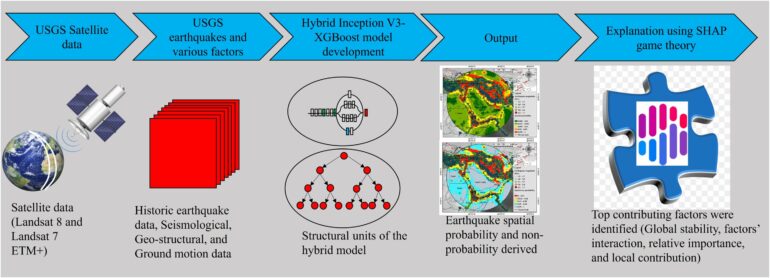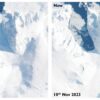Scientists say they have developed an artificial intelligence (AI) model which would efficiently interpret and recognize the behavior of certain factors in seismic-prone regions to forecast earthquakes before their occurrence.
In their study, published in the journal Remote Sensing, the scientists’ investigation centers on the Arabian Peninsula or Arabia located in West Asia and northeast Africa. In seismic research, it is technically referred to as the Arabian Plate, a minor tectonic plate in the Northern and Eastern Hemispheres.
Geographically, the Arabian Peninsula is known to cover Saudi Arabia, Yemen, the United Arab Emirates (UAE), Oman, Kuwait, Bahrain, Qatar including southern Iraq and Jordan.
While not an epicenter, the Arabian Peninsula is bordered by active tectonic enclaves. The selected buffer area (2,000 km radius) which the study examines is centroid by Saudi Arabia, which the authors say is either unexplored or partially explored in the literature.
The literature on earthquake prediction is voluminous, the scientists point out; however, their review of previous scholarly work shows that, only very few studies have used artificial intelligence in spatial probability assessment (SPA).
SPA shows the future distribution of earthquakes of a certain magnitude and the possibility of them recurring in a specific area. But the scientists find a great deal of complexity in the available SPA modeling processes due to what they describe as “the involvement of seismological to geological factors.”
Despite the plethora of SPA-based studies, earthquake prediction remains an arduous task. Hope for improved accuracy of earthquake prediction only emerged with the publication of some recent AI-based seismic studies whose data included certain integrated factors such as ground shaking gap, and tectonic contacts, the scientists emphasize.
The literature diverges in reporting seismic activity in the geographical boundaries of the Arabian Peninsula. Some studies mention that it is a stable craton, while others report small magnitude events. Within the Peninsula, the authors mention the occurrence of small-to-moderate earthquakes.
The study stands out in developing a hybrid Inception v3-ensemble extreme gradient boosting (XGBoost) model and shapely additive explanations (SHAP). XGBoost is a powerful efficient algorithm for models relying on classification and regression, while SHAP is a game approach used to explain machine learning output.
The authors claim their study is the first ever to use XAI for SPA.
The inventory data used for analysis in the study was collected from the US Geological Survey (USGS) for the past 22 years ranging the magnitudes from 5 Mw and above. Landsat-8 satellite imagery and digital elevation model (DEM) data were also incorporated in the analysis.
“Results revealed that the SHAP outputs align with the hybrid Inception v3-XGBoost model (87.9% accuracy) explanations,” the scientists write.
Drawing on the study’s outcome, the scientists attribute failure by previous models to accurately forecast quake occurrence to failure in adding new factors to the body of their data and analysis.
It is essential for earthquake prediction models “to add new factors such as seismic gaps and tectonic contacts, where the absence of these factors makes the prediction model perform poorly,” the study points out.
Hitherto, the most missing critical factors for SPA, according to the study, are peak ground accelerations (PGA), magnitude variation, seismic gap, and epicenter density.
“The conclusions drawn from the explainable algorithm depicted the importance of relevant, irrelevant, and new futuristic factors in AI-based SPA modeling,” they write.
They say that last year’s Turkey earthquakes (Mw 7.8, 7.5, and 6.7), mostly attributed to the active east Anatolian fault, validate the AI-based earthquake SPA results they have obtained.
Conducting their SPA, the scientists used a combined approach of ML and XAL techniques. For the sake of clarity, they developed a hybrid combination of the inception v3-XGBoost model because “feature learning is still unclear in the literature.”
“This hybrid model performs both feature learning and prediction better than the standalone models. The model deeply analyzes the features to improve processes, automate tasks, and predict outcomes, based on past experiences,” the study says.
The results of the study show that future earthquakes are likely to happen within their mapped seismic zones. However, they write, “This might not happen in the Arabian Plate as few areas in the peninsula have shown seismic quiescence for a long period.”
The authors convey that the AI model they have adopted improves the previous works investigating seismic activity in the Arabian Peninsula. However, they stress that “[a] large area of study needs a huge amount of training data for better accuracy. This can be studied using smart predictors to improve the SPA map.”
“The proposed hybrid Inception V3-XGBoost model achieved good accuracy as compared to other state-of-the-art ML models. However, the CNN model achieved a better accuracy in prediction which is 90%.”
Despite their promising findings, the authors reiterate the challenging character of the earthquakes’ spatial probability assessment “among all natural hazards owing to multiple factors and event non-linearity.”
The advantages of the study, the authors add, “deal with operationalizing AI that builds confidence in black-box models and monitors the models to optimize.”
Of the implication of the research to regions other than the Arabian Peninsula, the scientists say that while their AI-driven model has provided a robust and effective approach to SPA, “its global acceptability should be further tested with new factors and geotectonic conditions.”
Among the study’s other important findings, the scientists have shown that dominant major parts of the Arabian Peninsula like Central Saudi Arabia, Egypt, and Sudan come under low probability levels of seismic events prediction.
“Very high probability index … can be found in the Gulf of Aden, Red Sea, Iran, and Turkey,” they write.
The authors cite the Mw 7.8 earthquake that struck Turkey last year and its corresponding aftershocks as an indication of the importance of their study and the validation of the results they have obtained.
In conclusion, the authors hope that their study will “substantially contribute to establishing seismic codes” for construction activities in the geographical regions the study has targeted as it provides some relevant parameters “to determine whether retrofitting is necessary to minimize ground-shaking effects in the Arabian Peninsula.”
More information:
Ratiranjan Jena et al, Explainable Artificial Intelligence (XAI) Model for Earthquake Spatial Probability Assessment in Arabian Peninsula, Remote Sensing (2023). DOI: 10.3390/rs15092248
Provided by
University of Sharjah
Citation:
Scientists develop AI model to predict earthquakes in Arabian Peninsula (2024, January 8)



